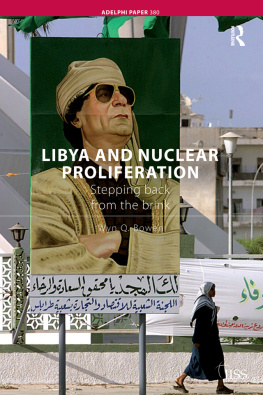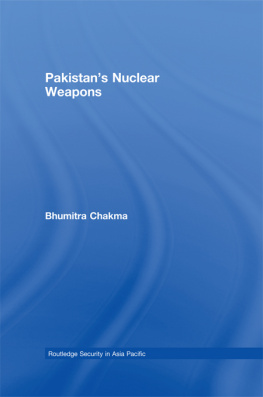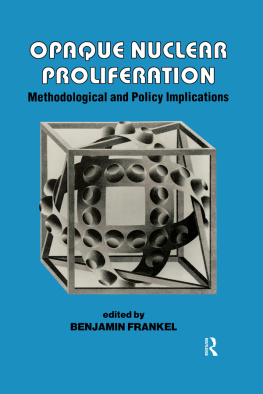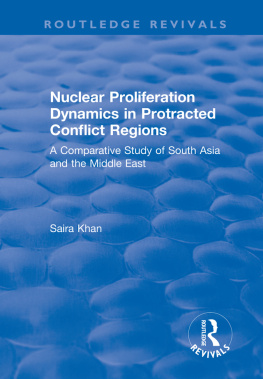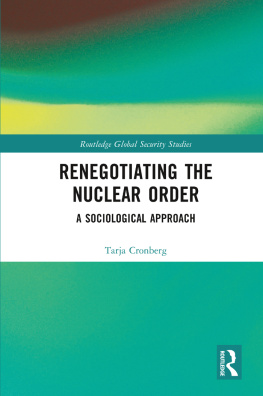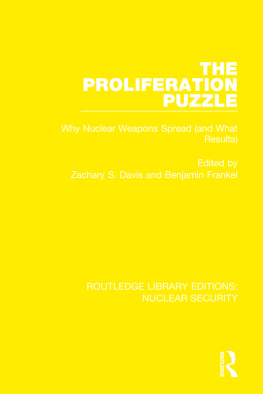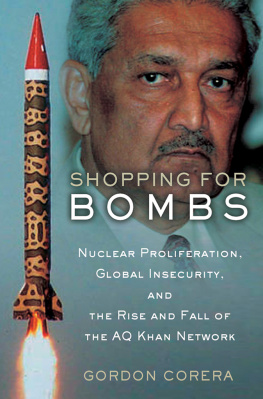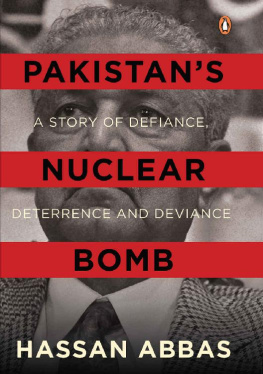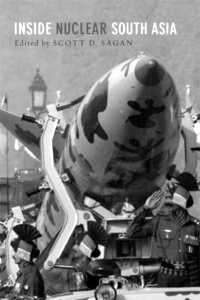Libya and Nuclear Proliferation
Stepping back from the brink
Wyn Q. Bowen
ADELPHI PAPER 380
The International Institute for Strategic Studies
Arundel House | 13-15 Arundel Street | Temple Place | London | WC2R 3DX | UK
ADELPHI PAPER 380
First published May 2006 by Routledge
2 Park Square, Milton Park, Abingdon, Oxon OX14 4RN
711 Third Avenue, New York, NY 10017, USA
Routledge is an imprint of the Taylor & Francis Group, an informa business
First issued in hardback 2017
Transferred to Digital Printing 2010
Copyright 2006 The International Institute for Strategic Studies
DIRECTOR-GENERAL AND CHIEF EXECUTIVE John Chipman
EDITOR Tim Huxley
MANAGER FOR EDITORIAL SERVICES Ayse Abdullah
ASSISTANT EDITOR Jessica Delaney
PRODUCTION Jesse Simon
COVER IMAGE Marwan Naamani/AFP/Getty Images
CARTOGRAPHER Steven Bernard
All rights reserved. No part of this book may be reprinted or reproduced or utilised in any form or by any electronic, mechanical, or other means, now known or hereafter invented, including photocopying and recording, or in any information storage or retrieval system, without permission in writing from the publishers.
Notice:
Product or corporate names may be trademarks or registered trademarks, and are used only for identification and explanation without intent to infringe.
British Library Cataloguing in Publication Data
A catalogue record for this book is available from the British Library
Library of Congress Cataloguing in Publication Data
ISBN 978-0-415-41238-4 (pbk)
ISBN 978-1-138-45212-1 (hbk)
ISSN 0567-932X
Contents
Guide

Libyas nuclear weapons programme, 19692003:
facilities and locations
Disclaimer
The analysis, opinions and conclusions expressed or implied in this paper are those of the author and do not necessarily represent the views of the JSCSC, the Defence Academy, the UK Ministry of Defence or of any other government agency.
ANO Abu Nidal Organisation
ADI Arab Development Institute
CTBT Comprehensive Test Ban Treaty
CWC Chemical Weapons Convention
HEU Highly Enriched Uranium
IAEA International Atomic Energy Authority
IDF Israeli Defense Force
ILP Islamic Liberation Party
IMM Islamic Martyrdom Movement
ILSA Iran-Libya Sanctions Act
IRA Irish Republican Army
IRT-1 IRT-1 research reactor
JIC Joint Intelligence Committee
LEU Low-Enriched Uranium
MTCR Missile Technology Control Regime
NBSR National Board of Scientific Research
NOC National Oil Corporation
NPT Nuclear Non-Proliferation Treaty
NSDD National Security Decision Directive
OPCW Organisation for the Prohibition of Chemical Weapons
OTA Office of Technology Assessment
PLO Palestinian Liberation Organisation
PSI Proliferation Security Initiative
RCC Revolutionary Command Council
SCOPE Scomi Precision Engineering
SIS Secret Intelligence Service
TNRC Tajoura Nuclear Research Centre
UCF Uranium-conversion facility
UF4 Uranium tetrafluoride
UF6 Uranium hexafluoride
UO2 Uranium dioxide
UO3 Uranium trioxide
U3O8 Uranium oxide concentrate ('yellowcake')
UAE United Arab Emirates
UNSCOM UN Special Commission in Iraq
WMD Weapons of mass destruction
The Libyan government announced on 19 December 2003 that it had chosen to abandon its nuclear and chemical weapons programmes, as well as to forego its long-range ballistic missile capability. The official statement announcing the decision noted that 'Libya has decided, with its own free will, to get rid of these substances, equipment and programmes and to be free from all internationally banned weapons'. The announcement took most non-proliferation practitioners and observers by surprise. It was the result of quiet negotiations involving Libya, Britain and the United States which had been the subject of intense secrecy with only a handful of officials in each government either involved in or aware of the talks. Libya would dismantle its nuclear and chemical weapons programmes completely and restrict its missile capability to systems with ranges of no greater than 300km in line with the parameters of the Missile Technology Control Regime (MTCR). A commitment was made to undertake these measures transparently, including the acceptance of international verification by the International Atomic Energy Agency (IAEA) and the Organisation for the Prohibition of Chemical Weapons (OPCVV) in the nuclear and chemical fields respectively.
The regime of Colonel Muammar Gadhafi had long been suspected of possessing chemical and, potentially, biological weapons capabilities. Its desire to acquire nuclear weapons was also well documented, despite Libya's status as a non-nuclear-weapon state under the Nuclear Non-Proliferation Treaty (NPT). Until Libya's decision to forego weapons of mass destruction (WMD), publicly available assessments generally concurred that-in the absence of significant and sustained injections of foreign technology and assistance-the country's technical and scientific capabilities were too under-developed to allow the indigenous development and production of nuclear weapons. However, since December 2003 it has emerged, as a result of investigations by America, Britain and the IAEA, that Libya was further advanced in the nuclear realm than previously thought.
It appears that Gadhafi's regime began seeking to acquire nuclear weapons shortly after seizing power from King Idris I in 1969. In an initial effort to procure such a capability directly 'off the shelf', the regime approached the People's Republic of China during the period 1969-71, although Beijing declined these advances. Ultimately, these efforts to acquire nuclear weapons came to nothing, thus increasing the importance of finding a source for the requisite technology, materials and components to manufacture nuclear weapons domestically.
From the 1970s to late 2003, Gadhafi's regime sought to acquire key elements of the nuclear-fuel cycle from abroad, notably uranium-enrichment capabilities. Ultimately, during the second half of the 1990s, Libya became a key beneficiary of the illicit proliferation network established by Pakistani scientist Abdul Qadir Khan. The A.Q. Khan network became a pivotal 'target of opportunity' for the regime from 1997 through to 2003, with the Libyans spending millions of dollars in return for significant infusions of nuclear technology and expertise.
This paper examines Libya's pursuit of a nuclear weapons capability and the factors that in the end influenced the Gadhafi regime to forego its ambitions in this area. It begins by examining the motives underlying Libya's nuclear ambitions from the 1970s through to the 1990s. The motives, or 'drivers', are placed into context through an examination of Gadhafi's foreign and security policies, including the ideological motivations that spawned its radical approach to international relations during this period. This provides the necessary background for examining the drivers in more detail. They revolved primarily around a security imperative, specifically the regime's desire to deter external interference and intervention in Libya by states in its immediate neighbourhood and further afield.

